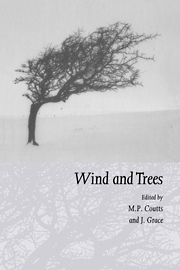Book contents
- Frontmatter
- Contents
- Preface
- List of contributors
- Part I Airflow over topography and in forests
- Part II Mechanics of trees under wind loading
- 7 Understanding wind forces on trees
- 8 Modelling mechanical stresses in living Sitka spruce stems
- 9 Experimental analysis and mechanical modelling of windinduced tree sways
- 10 Failure modes of trees and related failure criteria
- 11 An experimental investigation of the effects of dynamic loading on coniferous trees planted on wet mineral soils
- 12 Measurement of wind-induced tree-root stresses in New Zealand
- 13 New methods for the assessment of wood quality in standing trees
- Part III Tree physiological responses
- Part IV Impacts of wind on forests and ecology
- Part V Risk assessment and management response
- Index
10 - Failure modes of trees and related failure criteria
Published online by Cambridge University Press: 27 October 2009
- Frontmatter
- Contents
- Preface
- List of contributors
- Part I Airflow over topography and in forests
- Part II Mechanics of trees under wind loading
- 7 Understanding wind forces on trees
- 8 Modelling mechanical stresses in living Sitka spruce stems
- 9 Experimental analysis and mechanical modelling of windinduced tree sways
- 10 Failure modes of trees and related failure criteria
- 11 An experimental investigation of the effects of dynamic loading on coniferous trees planted on wet mineral soils
- 12 Measurement of wind-induced tree-root stresses in New Zealand
- 13 New methods for the assessment of wood quality in standing trees
- Part III Tree physiological responses
- Part IV Impacts of wind on forests and ecology
- Part V Risk assessment and management response
- Index
Summary
Abstract
Three failure modes of trees are described, selected from a more extensive study, because of their practical importance. These are: failure of hollow trees, axial splitting of hazard beams, and windthrow.
Failure of hollow trees by cross-sectional flattening
The failure mechanism observed in nature in hundreds of hollow trees is shown in Fig. 10.1. Hollow trees will fail when a certain ratio of wall thickness t to stem radius R is reached. The failure mechanism by cross-sectional flattening is due to lateral forces which increase with the curvature of the ‘pipe’ due to bending. At a certain degree of flattening the hoop stresses exceed the value of circumferential strength resulting in axial splitting. When the hollow tree collapses into individual timber boards the stiffness is dramatically reduced and overall breakage will normally happen. It has been shown in a field study (Mattheck et al., 1993) with more than 700 trees that failure can start if 68–70% of the stem radius is hollow or decayed wood (Figs. 10.1, 10.2). This failure has to be expected if the crown of the tree is not reduced and therefore the full canopy (sail) area is under wind loading. If, on the other hand, the crown volume is reduced, it is possible that trees with even much smaller t/R ratios will resist the wind, with a much smaller canopy.
Axial splitting of hazard beams
Lateral forces are also responsible for axial splitting of hazard beams.
- Type
- Chapter
- Information
- Wind and Trees , pp. 195 - 203Publisher: Cambridge University PressPrint publication year: 1995
- 3
- Cited by



